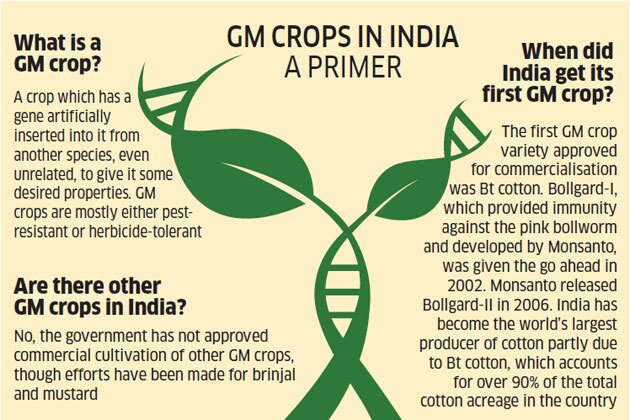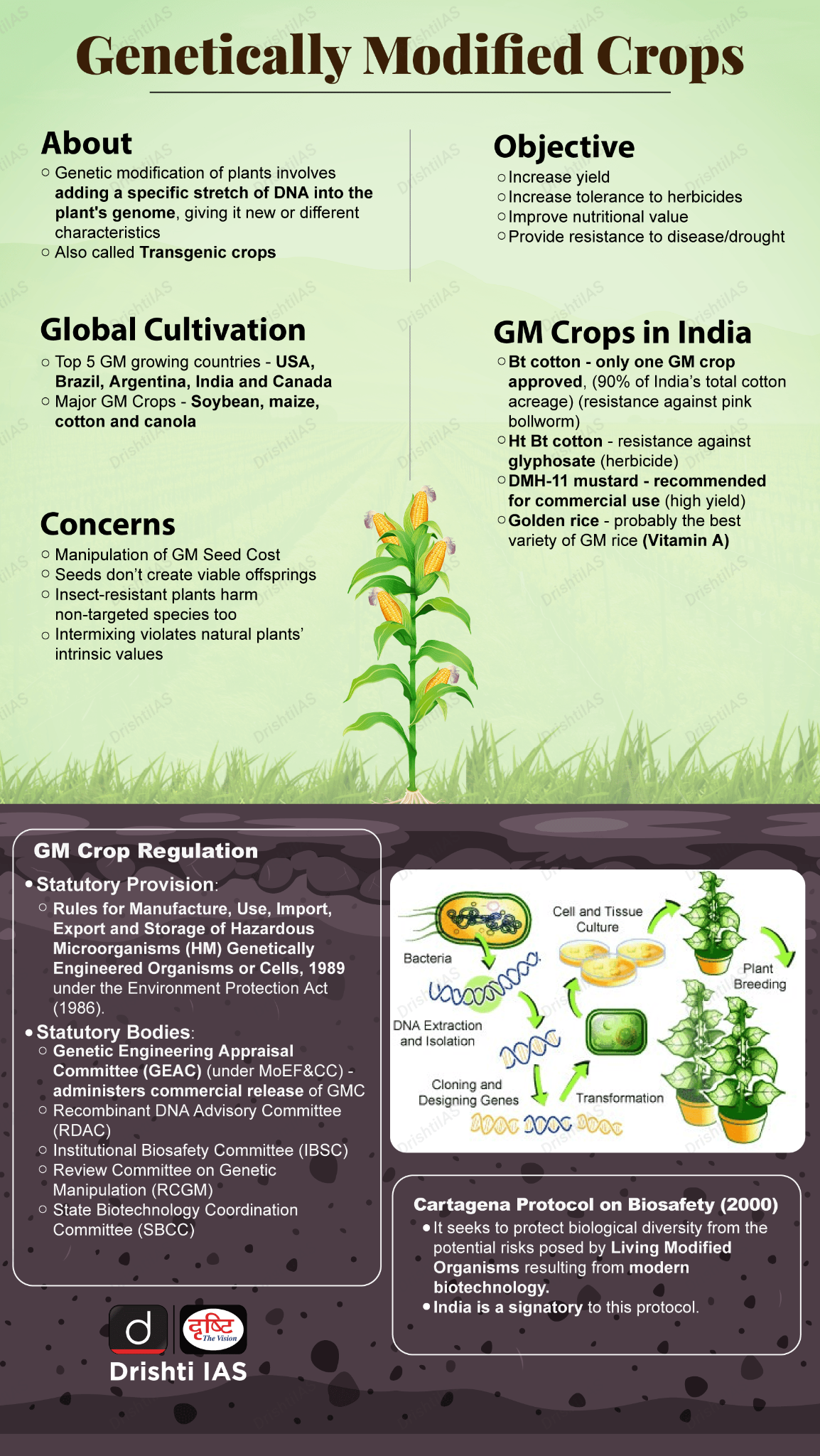Science & Technology
Philippines Halted Production of GM Crops
- 04 Jun 2024
- 12 min read
For Prelims: Genetically Modified Organism (GMO), DNA, Recombinant DNA Technology, Genetically Modified (GM) crops, Bt cotton, Genetic Engineering Appraisal Committee (GEAC), Dhara Mustard Hybrid-11 (DMH-11), ‘Early Heera-2’ mustard, Bacillus amyloliquefaciens,
For Mains: Implication of Genetically Modified Organism (GMO) on Human Health, Significance of Genetically Modified Crops in achieving Sustainable Development Goal 2: Zero Hunger.
Why in News?
Recently, a court in the Philippines has canceled the permits that allowed for the commercial cultivation of Genetically Modified (GM) Golden Rice and Bt Eggplant in the country.
- Critics argue that the decision could harm children with vitamin A deficiency, but the court's concerns about safety violations are being ignored.
Note
- In 2013, the World Health Organization (WHO) identified vitamin A deficiency as a public health issue that impacted approximately one third of children between the ages of 6 and 59 months, with the highest prevalence in sub-Saharan Africa (48%) and South Asia (44%).
What is GM Golden Rice and Bt Eggplant?
- GM Golden Rice:
- It was first developed in the late 1990s by researchers at the Swiss Federal Institute of Technology and the International Rice Research Institute.
- Golden rice is a type of rice that has been genetically modified to have higher amounts of iron and zinc, as well as beta-carotene, which the body can turn into vitamin A.
- This rice gets its name from its distinctive yellow colour.
- This was developed to address vitamin A deficiency, a significant public health issue in many developing countries.
- Vitamin A deficiency is a major cause of blindness and increases the risk of death from common childhood illnesses, especially in low- and middle-income countries.
- Golden Rice has the potential to provide up to 50% of the recommended daily intake of vitamin A, helping to address this critical public health issue.
- Bt Eggplant:
- It was developed by the Indian seed company Mahyco (Maharashtra Hybrid Seeds Company) in collaboration with the University of Agricultural Sciences, Dharwad.
- Bt eggplant is a genetically modified variety of eggplant (Brijal) that has been engineered to produce a protein from the Bacillus thuringiensis (Bt) bacteria, which is toxic to certain insect pests.
- This helps reduce the need for pesticide applications.
- It was approved for cultivation in Bangladesh in 2013, making it the first GM food crop to be approved in South Asia.
- In India, the commercial release of Bt eggplant was halted in 2010 due to concerns raised by environmental activists and some state governments.
What are Genetically Modified (GM) Crops?
- About:
- Cultivation: Global Scenario and India:
- According to the International Service for the Acquisition of Agri-biotech Applications (ISAAA), the global area under GM crops reached 191.7 million hectares in 2020.
- India first and only commercially approved the cultivation of Bt cotton, a GM crop, in 2002.
- Since then, the area under Bt cotton has grown significantly, reaching 11.6 million hectares in 2020, which is 94% of the total cotton area in the country.
- GM Organism (GMO) vs Transgenic Organisms:
- GMO and transgenic organism are two terms that are used interchangeably.
- Although both have altered genomes, a transgenic organism is a GMO containing a DNA sequence or a gene from a different species.
- While a GMO is an animal, plant, or microbe whose DNA has been altered using genetic engineering techniques.
- Thus, all transgenic organisms are GMOs, but not all GMOs are transgenic.
- Potential Benefits of GM Crops:
- Increased Productivity: GM crops can be engineered to have higher yields, improved resistance to pests and diseases, and better tolerance to environmental stresses like drought, salinity, or extreme temperatures.
- Enhanced Nutritional Value: GM crops can be modified to have increased levels of vitamins, minerals, or other beneficial compounds, potentially improving food security and nutrition.
- Reduced Reliance on Pesticides: GM crops with built-in pest resistance can reduce the need for chemical pesticides, leading to lower environmental impact and reduced agricultural costs.
- Potential Concerns:
- Environmental Risks: There are concerns about the potential for GM crops to have unintended ecological consequences, such as the development of herbicide-resistant weeds or the impact on non-target organisms.
- Human Health Risks: Long-term effects of consuming GM foods on human health are not yet fully understood, and there are concerns about potential allergenicity or toxicity.
- Impact on Non-target Organisms: The possibility of unintended consequences on beneficial insects and other organisms in the ecosystem due to GM crops needs careful evaluation.
- Ethical and Socioeconomic Considerations: There are debates around the concentration of ownership and control of GM technologies, as well as the impact on small-scale farmers and traditional agricultural practices.
- Self-Terminating seeds (sterile seeds after plant harvest) produced by GM technology will make it impossible for farmers to use their traditional right to save the seed of their harvest for planting in the next crop season.
Fortification of Food
- It refers to addition of key vitamins and minerals such as iron, iodine, zinc, Vitamin A & D to staple foods such as rice, milk and salt to improve their nutritional content.
- Example, the addition of iodine to salt is crucial for preventing thyroid-related disorders.
- These nutrients may or may not have been originally present in the food before processing.
- It can be used to address the issue of high levels of malnutrition among women and children in India.
- In India, every second woman in the country is anemic and every third child is stunted.
- Rice Fortification:
- Fortifying rice is a cost-effective way to increase its vitamin and mineral content like iron, folic acid, and Vitamin B-12 and other micronutrients like zinc.
- Initiatives:
- Nationwide Fortification Regulations: In 2016, the FSSAI implemented regulations to fortify staple foods like wheat flour, rice, milk, and edible oil. This adds essential nutrients like iron, vitamin B12, folic acid, vitamins A & D, and iodine to commonly consumed items.
- Pilot Programs: Milk Fortification Project.
What is the Regulatory Framework for GM Crops in India?
- Genetic Engineering Appraisal Committee (GEAC) is responsible for evaluating and approving the cultivation of GM crops.
- The committee is also responsible for appraisal of proposals relating to release of genetically engineered (GE) organisms and products into the environment including experimental field trials.
- GEAC is chaired by the Special Secretary/Additional Secretary of MoEF&CC and co-chaired by a representative from the Department of Biotechnology (DBT).
- GM foods are also subjected to regulations by the Food Safety and Standards Authority of India (FSSAI) under the Food Safety and Standards Act, 2006.
- Acts and Rules that Regulate GM Crops in India:
- Environment Protection Act, 1986 (EPA),
- Biological Diversity Act, 2002,
- Plant Quarantine Order, 2003,
- GM policy under Foreign Trade Policy, Food Safety and Standards Act, 2006,
- Drugs and Cosmetics Rule (8th Amendment), 1988.
Way Forward
- Strengthening the Regulatory Umbrella: The existing regulatory system should be bolstered with enhanced transparency, robust scientific evaluation processes, and clear communication with stakeholders. This will inspire public confidence and ensure responsible adoption of GM technology.
- Streamlining Approvals for Innovation: India can explore streamlining technology approval processes without compromising scientific rigour. Time-bound evaluations based on robust scientific data can expedite the introduction of beneficial GM crops while upholding safety standards.
- Science-Driven Decision Making: Policy decisions regarding GM crops should be firmly rooted in scientific evidence. Independent, transparent scientific assessments can guide regulatory processes and public discourse, fostering trust and informed decision-making.
- Rigorous Monitoring and Enforcement: A robust monitoring system is essential to ensure strict adherence to safety protocols throughout the GM crop cultivation cycle.
- Stringent enforcement mechanisms are crucial to prevent the spread of unapproved or illegal GM crops, safeguarding the integrity of the agricultural sector.
Conclusion
The debate around GM crops remains complex, with proponents highlighting the potential benefits and critics raising valid concerns. Continued research, transparent regulation, and inclusive stakeholder dialogue will be crucial in navigating the opportunities and challenges of this technology to ensure sustainable and equitable agricultural development.
|
Drishti Mains Question: Analyse the concerns associated with GM crops. How can India navigate these concerns to ensure the responsible adoption of this technology? |
UPSC Civil Services Examination Previous Year Question (PYQ)
Prelims
Q1. Other than resistance to pests, what are the prospects for which genetically engineered plants have been created? (2012)
- To enable them to withstand drought
- To increase the nutritive value of the produce
- To enable them to grow and do photosynthesis in spaceships and space stations
- To increase their shelf life
Select the correct answer using the codes given below:
(a) 1 and 2 only
(b) 3 and 4 only
(c) 1, 2 and 4 only
(d) 1, 2, 3 and 4
Ans: (c)
Mains:
Q. What are the present challenges before crop diversification? How do emerging technologies provide an opportunity for crop diversification? (2021)
Q. What are the research and developmental achievements in applied biotechnology? How will these achievements help to uplift the poorer sections of the society? (2021)
Q. How is science interwoven deeply with our lives? What are the striking changes in agriculture triggered off by science-based technologies? (2020)
Q. How was India benefited from the contributions of Sir M. Visvesvaraya and Dr. M.S. Swaminathan in the fields of water engineering and agricultural science respectively? (2019)







-min.jpg)